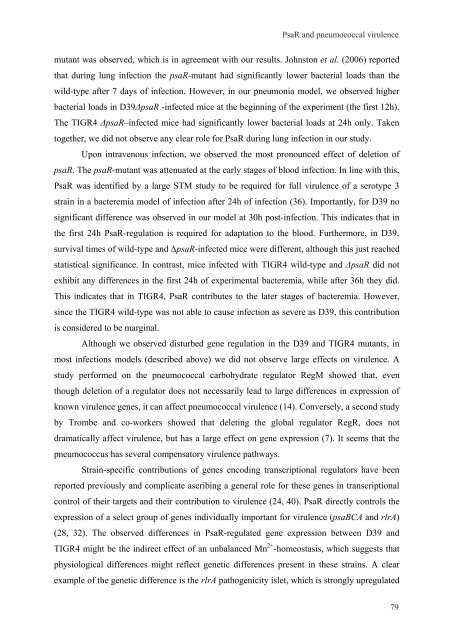Gene regulation in Streptococcus pneumoniae - RePub - Erasmus ...
Gene regulation in Streptococcus pneumoniae - RePub - Erasmus ...
Gene regulation in Streptococcus pneumoniae - RePub - Erasmus ...
Create successful ePaper yourself
Turn your PDF publications into a flip-book with our unique Google optimized e-Paper software.
PsaR and pneumococcal virulence<br />
mutant was observed, which is <strong>in</strong> agreement with our results. Johnston et al. (2006) reported<br />
that dur<strong>in</strong>g lung <strong>in</strong>fection the psaR-mutant had significantly lower bacterial loads than the<br />
wild-type after 7 days of <strong>in</strong>fection. However, <strong>in</strong> our pneumonia model, we observed higher<br />
bacterial loads <strong>in</strong> D39ΔpsaR -<strong>in</strong>fected mice at the beg<strong>in</strong>n<strong>in</strong>g of the experiment (the first 12h).<br />
The TIGR4 ΔpsaR–<strong>in</strong>fected mice had significantly lower bacterial loads at 24h only. Taken<br />
together, we did not observe any clear role for PsaR dur<strong>in</strong>g lung <strong>in</strong>fection <strong>in</strong> our study.<br />
Upon <strong>in</strong>travenous <strong>in</strong>fection, we observed the most pronounced effect of deletion of<br />
psaR. The psaR-mutant was attenuated at the early stages of blood <strong>in</strong>fection. In l<strong>in</strong>e with this,<br />
PsaR was identified by a large STM study to be required for full virulence of a serotype 3<br />
stra<strong>in</strong> <strong>in</strong> a bacteremia model of <strong>in</strong>fection after 24h of <strong>in</strong>fection (36). Importantly, for D39 no<br />
significant difference was observed <strong>in</strong> our model at 30h post-<strong>in</strong>fection. This <strong>in</strong>dicates that <strong>in</strong><br />
the first 24h PsaR-<strong>regulation</strong> is required for adaptation to the blood. Furthermore, <strong>in</strong> D39,<br />
survival times of wild-type and ΔpsaR-<strong>in</strong>fected mice were different, although this just reached<br />
statistical significance. In contrast, mice <strong>in</strong>fected with TIGR4 wild-type and ΔpsaR did not<br />
exhibit any differences <strong>in</strong> the first 24h of experimental bacteremia, while after 36h they did.<br />
This <strong>in</strong>dicates that <strong>in</strong> TIGR4, PsaR contributes to the later stages of bacteremia. However,<br />
s<strong>in</strong>ce the TIGR4 wild-type was not able to cause <strong>in</strong>fection as severe as D39, this contribution<br />
is considered to be marg<strong>in</strong>al.<br />
Although we observed disturbed gene <strong>regulation</strong> <strong>in</strong> the D39 and TIGR4 mutants, <strong>in</strong><br />
most <strong>in</strong>fections models (described above) we did not observe large effects on virulence. A<br />
study performed on the pneumococcal carbohydrate regulator RegM showed that, even<br />
though deletion of a regulator does not necessarily lead to large differences <strong>in</strong> expression of<br />
known virulence genes, it can affect pneumococcal virulence (14). Conversely, a second study<br />
by Trombe and co-workers showed that delet<strong>in</strong>g the global regulator RegR, does not<br />
dramatically affect virulence, but has a large effect on gene expression (7). It seems that the<br />
pneumococcus has several compensatory virulence pathways.<br />
Stra<strong>in</strong>-specific contributions of genes encod<strong>in</strong>g transcriptional regulators have been<br />
reported previously and complicate ascrib<strong>in</strong>g a general role for these genes <strong>in</strong> transcriptional<br />
control of their targets and their contribution to virulence (24, 40). PsaR directly controls the<br />
expression of a select group of genes <strong>in</strong>dividually important for virulence (psaBCA and rlrA)<br />
(28, 32). The observed differences <strong>in</strong> PsaR-regulated gene expression between D39 and<br />
TIGR4 might be the <strong>in</strong>direct effect of an unbalanced Mn 2+ -homeostasis, which suggests that<br />
physiological differences might reflect genetic differences present <strong>in</strong> these stra<strong>in</strong>s. A clear<br />
example of the genetic difference is the rlrA pathogenicity islet, which is strongly upregulated<br />
79<br />
79

















